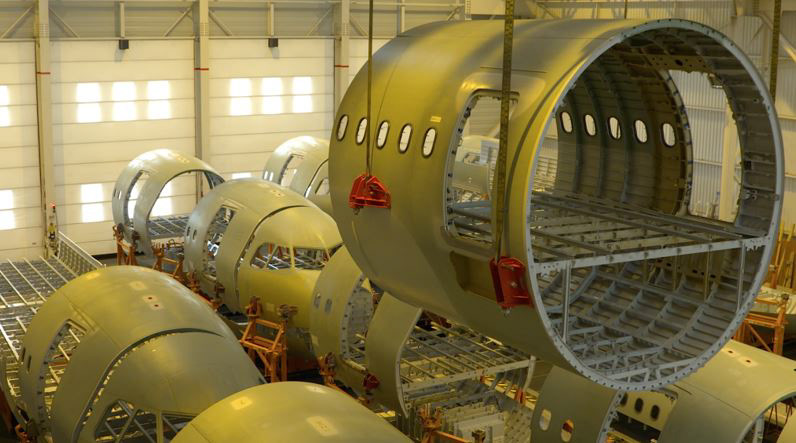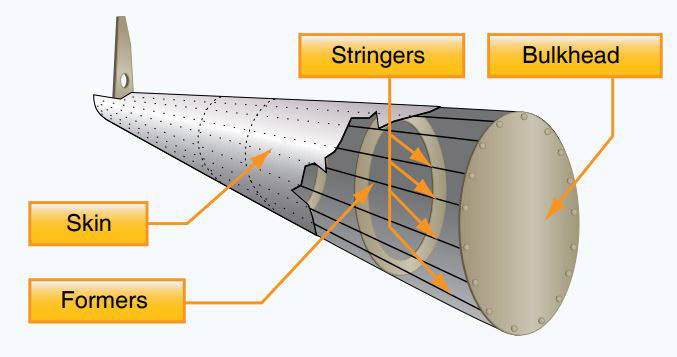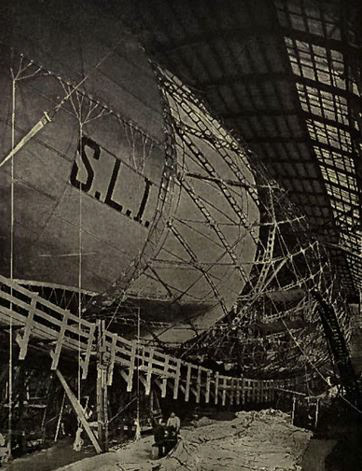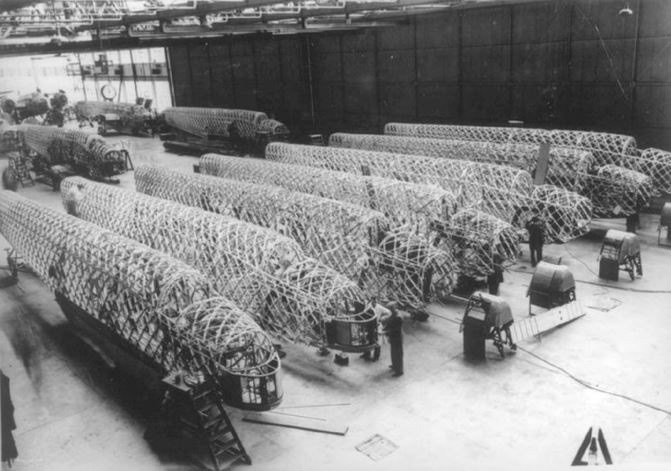Fuselage & Aircraft structures
Aircraft fuselage
The fuselage is one of the major components of an aircraft, aside from the wings and control surfaces, as it decides the purpose of the aircraft. Using a commercial airliner for reference, a fuselage is generally a central hollow tube which holds the wings and stabilizers together. Fuselages are designed to carry loads such as cargo or passengers. They decide the center of gravity of the aircraft, especially in cargo aircrafts.
Picture below a 3D animation of a fuselage.

With reference to combat aircrafts, they are designed to perform challenging missions. For example, a bomber has a fuselage which is designed commonly like a hollow tube, whereas a fighter aircraft has a fuselage which is thin and sleek for aerodynamic and stealth purposes. They vary distinctly from civilian aircrafts along with the materials and technologies used to build them, but let’s save combat aircrafts for another day.
History
Beginning of the era of aviation, the obvious tendency of all aeronautical engineers was to make the aircraft as light as possible. With limited innovations in the engines present back then, it was necessary to use wood to make the aircraft lighter, wood which has high strength to weight ratio. In the case of the Wright Brothers, wood of the tree Giant Spruce was used but over time, wood was replaced with other materials.
Modern era
With modern advancements in the aviation industry, engine power and thrust is no longer a major issue, but building the aircraft structurally strong and keeping the aircraft eco-friendly was a major concern. Then came aluminum, which alloyed with other metals, made it further strong and light.
Types of fuselage
Truss Structure – This is one of the older types of fuselage structures found in the first generations of aircrafts, still used in some lightweight aircrafts such as the Piper PA -18. The fuselage is made of interconnected rounded light gauge steel or wooden rods forming a web like structure with diagonal web members and vertical web members connected to common longerons, giving a rigid triangular structure which are rounded with stringers for aerodynamic purposes.
Pictured below is a truss structured fuselage.

Monocoque Structure - Monocoque structure is a shell-like structure which is constructed using internal frames to give the necessary structure. The internal circular frames are also known as formers. These formers when covered with a skin give the shape the fuselage, this is the skin which takes up all the flight loads and is the one which gives the aircraft its rigidity.
Since the skin shell bears the major load of the aircraft, the structure requires constant maintenance as any damage to the skin shell results in the decrease of the load bearing capacity of the skin shell. It is also difficult to place windows and doors to the structure as it interferes with the integrity of the airframe. Therefore, this type of fuselage structure does not make a good candidate for airliners.
Cross-section of a moncoque structure.

Semi-monocoque – After exploring the limitations of the monocoque shell, it was discovered that by making a few structural modifications, the fuselage became significantly stronger, especially best for big commercial aircrafts. Just like the monocoque shell, a series of formers are placed along the length of the aircraft according to the fuselage design. These formers are interconnected longitudinally with each other with a series of stringers (components in an aircraft which are used along with longerons to form strong structural frameworks). The skin is then attached on to the stringers by riveting. The skin is then cut wherever necessary for the doors and windows. Bulkheads are made very strong and are used to make compartments inside the aircraft. These bulkheads are connected to the formers because they too bare the load of the aircraft.
Semi-monocoque structure is one of the more modern concepts and is widely used by both, commercial airliners and the military.
A section of an Airbus 320 fuselage.

Cross-section of a semi-monocoque.

Geodesic Fuselage – This type of fuselage was used in aircrafts as early as WWI. They are extremely strong, light and rigid. This type of airframe uses multiple strip stringers which are flat, interconnected at certain angles to one another. These stingers which are interconnected bear all the torsional load of the fuselage’s curvature.
A Schütte-Lanz geodesic airship.

By using this type of aircraft fuselage where the structure is at the outer part of the airframe meant that there was a larger amount of space available for interior payload. The structure was able to take significant physical damages and combat damages, which along with its large payload room and structural strength, found significant use in early bombers. These bombers, due to their large size and minimal agility often used to take a lot of firepower. Apart from the bombers, these structures were also used in huge airships.
Vickers Wellesley Light Bomber fuselage

Although geodesic structures have great advantages, these structures are very difficult to repair and rebuild. If a plane needed to be extended, it would be very difficult to introduce a new section into that framework.
Image Courtesies:
Barnes Wallis Foundation
FAA PHAK
Stelia Aerospace
Autodesk Design Academy
References:
https://www.barneswallisfoundation.co.uk/life-and-work/geodetic-aircraft-design/
https://en.wikipedia.org/wiki/Aviation_in_World_War_I
http://www.stelia-aerospace.com/en/en/
https://aviation.stackexchange.com/questions/12277/why-are-geodesic-airframes-no-longer-produced
https://www.instructables.com/id/geodesic-airplane-construction/
https://www.pprune.org/tech-log/443767-geodesic-airframes.html
http://aviationknowledge.wikidot.com/aviation:fuselage-components-and-airframe-structure
https://www.faa.gov/regulations_policies/handbooks_manuals/aviation/phak/media/05_phak_ch3.pdf
https://www.britannica.com/technology/monocoque
https://okigihan.blogspot.com/p/fixed-wing-aircraft-fuselage-fuselage.html
http://www.flightlearnings.com/2011/03/20/types-of-aircraft-construction-truss-structure/

